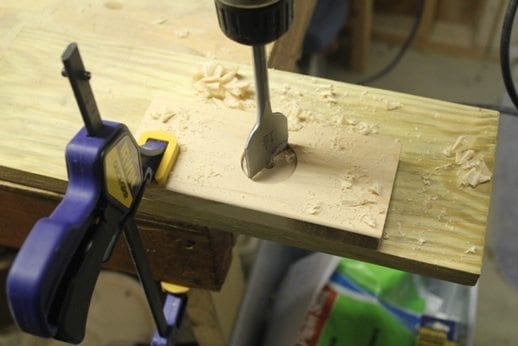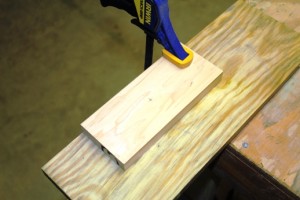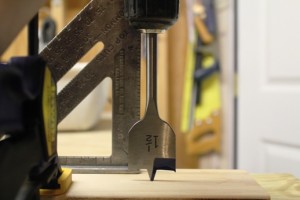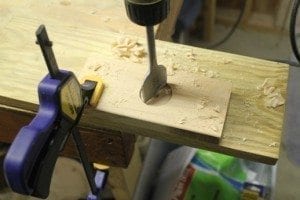
How to drill large holes with a spade bit

Clearly and precisely mark the center of the hole, and securely clamp the piece you are drilling to a piece of scrap and a work surface.

Hold your drill so the shank is at a right angle to the work piece. This speed square is in the photo only to show the correct position – never use a spade bit in close proximity to any obstruction.
The best way to get a precise large-diameter hole is with a drill press and forstner bits, but what if you’re on the jobsite or don’t have a drill press? Don’t worry; all it takes is a drill, spade bit, steady hands and a careful eye to drill a crisp, clean hole exactly where you want it.
Spade bits – sometimes called paddle bits – have a sharp pilot point in the middle of a flattened blade-like structure. The flat portion features sharpened edges and sometimes may even have a pointed tip on the outside edge to cleanly score the outline of the hole as you drill it.
Auger bits and hole saws are other options for drilling large-diameter holes on the jobsite. However, auger bits are sometimes too aggressive and leave a hole with rough edges, and hole saws are not as fast as spade bits. Plus, removing the plugs from the bit after drilling can be difficult.

Start the hole by spinning the bit into the work piece slowly and steadily. Once the hole begins to take shape, you can begin spinning the bit faster while maintaining steady control.
Before you begin to drill largo holes
The first step to drill large holes with a spade bit is to mark the center point of the hole to be drilled on the wood. With the spade bit installed securely in the drill’s chuck, press the pilot point firmly into the wood at the center point. If you’re worried that the spade bit will “walk” away from the center point as you begin drilling, you can drill a small (1/8-inch or smaller) pilot hole in the wood at the center point before using the spade bit.
Before you begin to drill large holes with a spade bit, make sure the wood is secure and stationary by either clamping it to a work surface or installing it in its final position.
Start the drill
Hold your drill so that the shank of the bit is at a 90-degree angle to the wood’s surface. Press the trigger slightly so the bit slowly turns and engages the wood surface gently. Once the bit has made an outline of the hole in the wood’s surface, increase the speed and drill the rest of the hole.
Once the bit comes through the other side of the wood, let the bit come to a complete stop and then pull it back out of the completed hole.
Avoid “blow out”
Spade bits can blow out the backside of a hole as you go through the wood, but there are a couple of ways to prevent this if you need both sides of the hole to be clean and sharply defined.
Drill a small pilot hole through the center point and drill most of the way through the wood from one side, then flip it over and insert the pilot point of the bit into the pilot hole and complete the hole from the other side.
Clamp a scrap piece of wood to the backside of the finished piece of wood so that when you drill through your work piece, the spade bit will continue into the scrap piece.

